Raman Lab facilities
Nano-optics
The Raman Lab shares space and facilities with the Nano-optics group led by Baptiste Auguie, which includes a single-nanoparticle micro-spectroscopy set-up and a CD spectrometer for circular dichroism.
Absorption spectroscopy in integrating spheres
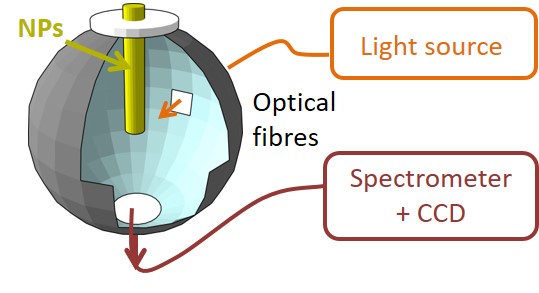
We have developed a suite of custom integrating-sphere based spectroscopy set-ups, designed to measure absorption in scattering samples. Wavelength range is from 250nm to 900nm.
The main application we have pursued is the measurement of the modified absorption of dyes on the surface of metallic nanoparticles.
The integrating spheres can be used for a variety of other applications including quantum yield measurements or absorbance measurements in strongly scattering media.
Combined extinction/absorption spectroscopy
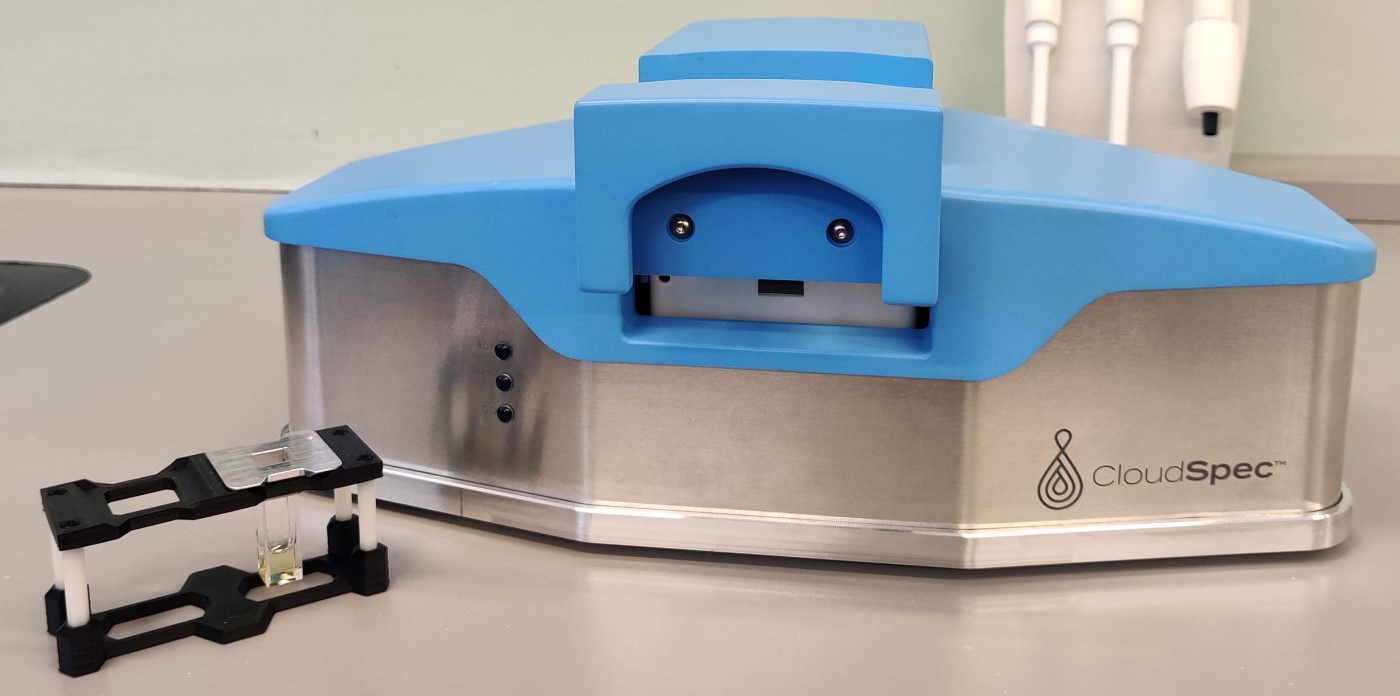
The Cloudspec instrument was developed by Marama Labs, a recent start-up spun out from research in the Raman Lab.
This instrument incorporates a unique mechanism to insert standard UV cuvettes inside a specially designed integrating sphere. A scattering-independent absorption spectrum can then be inferred using algorithms to correct for the modified path length inside the cuvette.
The CloudSpec simultaneously carries out a standard UV-Vis extinction measurement. It therefore works as a standard UV-Vis (giving extinction spectra) with the additional benefit of providing the absorption-only spectra.
The Cloudspec can measure absorption spectra on turbid samples such as metallic nanoparticles, non-soluble compounds/powders, live cells, bacteria, milk, and so on.
LabRam Raman system
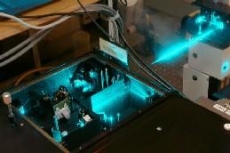
The LabRam is a new generation of Raman microscope and the instrument of choice for fast, analytical Raman spectroscopy.
It is a fully integrated system designed for many applications, such as with electronics, chemicals, biomedical products, pharmaceuticals, forensics, environmental samples, polymers, and thin films.
The single-stage spectrometer takes advantage of a highly sensitive CCD detection system and laser notch filter technology. The two gratings mounted on a translating shaft give complete spectral coverage (200-4,000 cm-1) in one hit.
Alternatively, sensitivity can be maximised at different excitation laser lines by selecting specifically optimised gratings. The system in our lab is fitted with lasers at 325 nm (He-Cadmium), 458 and 514 nm (Ar-ion), 633 nm (HeNe), and 785 nm (laser diode).
Triple additive/subtractive Raman spectrometer
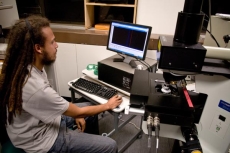
A triple additive/subtractive Raman spectrometer facility (Jobin-Yvon T64000) is the second spectrometer purchased by the MacDiarmid Institute for our laboratory. It is available for use by the Institute, the School of Chemical and Physical Sciences, and outside clients.
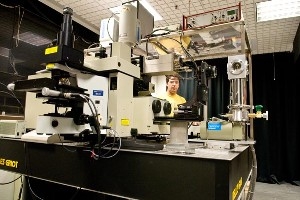
The spectrometer is coupled to a confocal Raman microscope and five different lasers: argon, krypton, helium-cadmium, helium-neon, and NIR-solid state.
The machine can be used as a single spectrometer with a notch filter, as a double subtractive spectrometer (when no notch filters are required), or as a double additive spectrometer (when the instrument acts as a high-resolution machine which can resolve atomic line splitting).
The spectrometer has both a nitrogen-cooled CCD detector and a photomultiplier (GaAs-cathode).
We have access to (Raman) mapping stages and low temperature conditions—down to 77 K for the microscope and 8 K in the separate closed cycle cryostat.
Spectroscopic ellipsometer
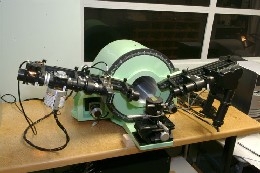
We operate a state-of-the-art spectroscopic ellipsometer from Beaglehole Instruments, New Zealand. This ellipsometer operates by polarisation modulation with an elasto-optic modulator—a method developed by David Beaglehole, a former Emeritus Professor at our School.
A wide wavelength range (196 to 2000 nm) can be used with this instrument. Below 850 nm a photomultiplier is used. In the IR range we make use of a silicon diode or silicon/InGaAs detector. And a deuterium light source is available for work in the far UV.
A Xe lamp is utilised for the UV to visible range and a quartz-halogen lamp for the visible to IR range.
We use the ellipsometer for projects such as studying GaN/InN thin films and the optical properties of polymer thin films.
Glass helium bath cryostat
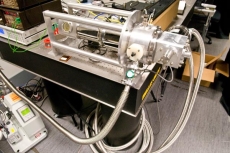
This is a standard helium bath cryostat comprising a glass liquid nitrogen jacket and a glass helium bath that house the stainless steel sample space. The system is designed to make measurements from room temperature to 1.3 K.
The fully evacuated sample space allows excellent isolation of the system from the environment, so very slow warm up can be achieved to ensure thermal equilibrium between the samples and the Rh-Fe thermometer.
The sample space has room for three samples. The contact geometry is optimised for low noise four-terminal resistance measurements that are especially useful for measuring the large resistance found in metals and superconductors.
MD4 stainless steel helium cryostat with magnet tail
This MD4 cryostat is fitted with an extension tail that houses the sample, allowing measurements to be carried out when the sample is between the poles of a magnet.
A carbon glass resistance thermometer measures temperatures from room temperature to 1.3 K. Extra care has been taken with this system to use continuous contact leads to avoid voltage noise associated with soldered connections.
In this cryostat the sample is immersed directly in liquid helium, resulting in both excellent temperature stability (± 1mK for T < 2.17 K, and ± 3 mK for T > 2.17 K) and very low voltage noise (< 0.1 m V).
This system has been invaluable for measuring the current-voltage characteristics of superconducting thin films in magnetic fields, both parallel and perpendicular to the film plane. A selection of current sources, voltage meters, and electrometers are available for measurements.
Closed cycle cryostat
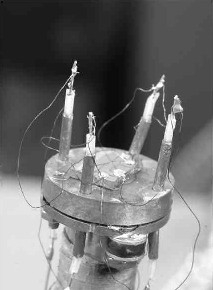
The closed cycle cryostat is capable of operating from above room temperature to ~10 K. It is equipped with optical ports that are used to make temperature dependent Raman measurements on samples such as high-temperature superconductors and colossal magnetoresistance manganites.
Two separate sets of contact leads are available for temperature-dependent resistance measurements. The first set of leads is optimized for four terminal measurements of low resistance samples, and has the leads thermally anchored to the sample block through metal-coated sapphire pads. The second set of contact leads are useful when the samples have resistance in giga-Ohms or greater, as often found for semiconductors or insulators.
A silicon diode thermometer measures the temperature of the sample block, and if required, a second miniature silicon diode can be attached directly to the sample.
Lasers
Lasers available for Raman excitation:
- He-Cadmium UV laser (325 nm)
- Blue and green lines of Ar-ion lasers (454 nm to 514 nm)
- Red He-Ne laser (633 nm)
- Near Infrared laser diode (785 nm)
- Krypton laser
